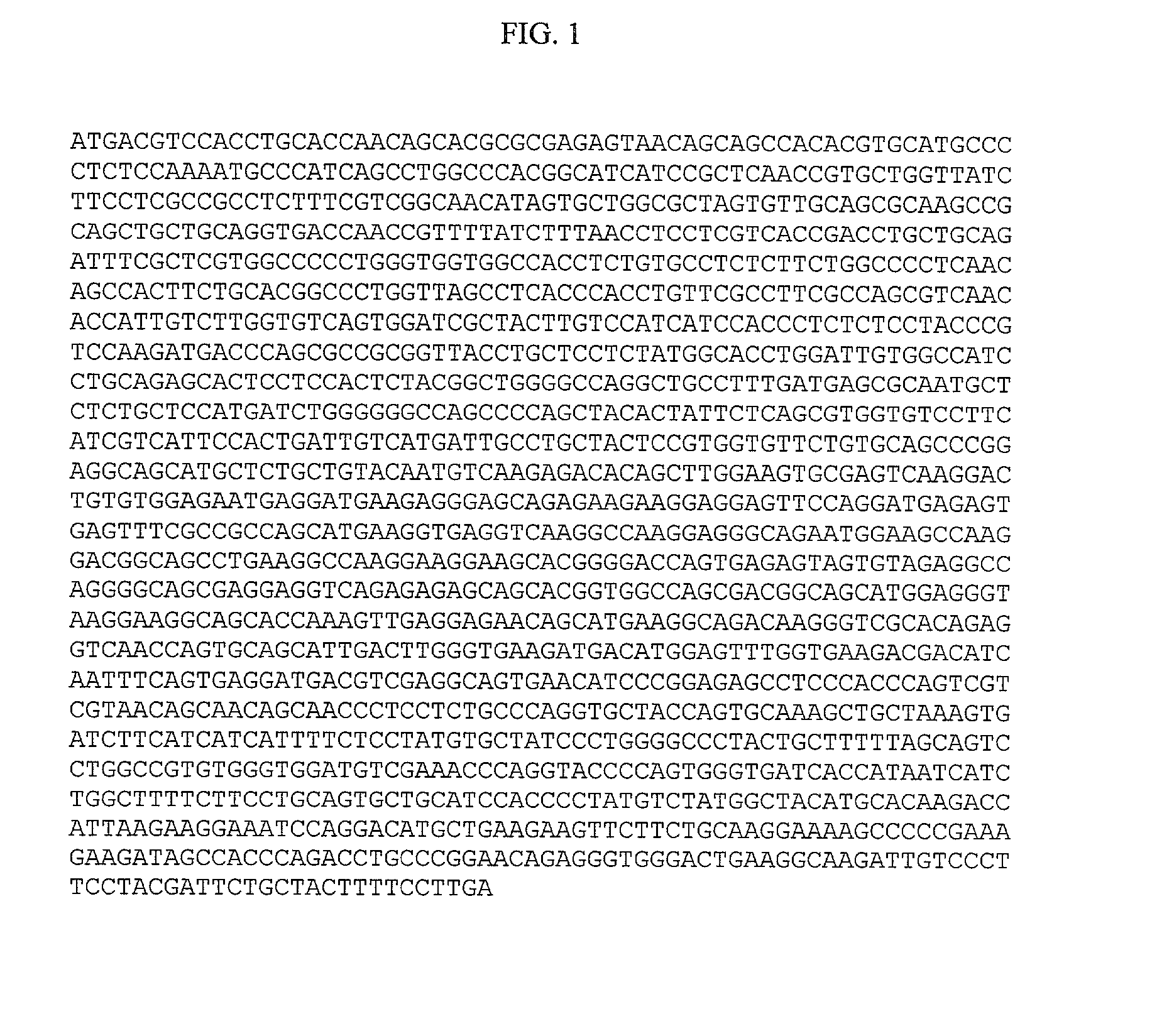Novel human G-protein coupled receptor, HGPRBMY8, expressed highly in brain
a human gprotein and receptor technology, applied in animal/human proteins, peptides/protein ingredients, peptides, etc., can solve the problems of low stringency and inability to permit non-specific binding, and achieve the effect of elevating expression in brain
- Summary
- Abstract
- Description
- Claims
- Application Information
AI Technical Summary
Benefits of technology
Problems solved by technology
Method used
Image
Examples
example 1
Bioinformatics Analysis
[0271] G-protein coupled receptor sequences were used as a probes to search human genomic sequence databases. The search program used was gapped BLAST (S. F. Altschul, et al., Nuc. Acids Res., 25:3389-4302 (1997)). The top genomic exon hits from the BLAST results were searched back against the non-redundant protein and patent sequence databases. From this analysis, exons encoding potential full-length sequence of a novel human GPCR, HGPRBMY8, was identified directly from the genomic sequence. The full-length clone of this GPCR was experimentally obtained by RT-PCR using the sequence from genomic data. The complete protein sequence of HGPRBMY8 was analyzed for potential transmembrane domains. TMPRED program (K. Hofmann and W. Stoffel, Biol. Chem., 347:166 (1993) was used for transmembrane prediction. The program predicted seven transmembrane domains and the predicted domains match with the predicted transmembrane domains of related GPCRs at the sequence level. ...
example 2
Cloning of the Novel Human GPCR HGPRBMY8
[0272] HGPRBMY8 was cloned from a human brain cDNA library (Clontech; Palo Alto, Calif.) by PCR amplification of the predicted cDNA sequence using sequence specific oligonucleotides. The 5' sense oligonucleotide was as follows:
[0273] 5'-GGCCGAATTCGCAACCTGTCTCACGCCCTCTGG-3' (SEQ ID NO:5). The 3' anti-sense oligonucleotide was as follows:
[0274] 5'-GGCCGAATTCGGACAGTTCAAGGTTTGCCTTAGAAC-3' (SEQ ID NO:6). These oligonucleotides contained EcoRI restriction enzyme sites for subcloning the PCR fragment into the mammalian expression vector, pcDNA6. Samples containing human brain cDNA, the 5 prime sense, and 3 prime anti-sense oligonucleotides were subjected to PCR amplification followed by gel purification of the amplified product. The inserts of cDNA clones that were positive by PCR were sized, and two of the largest clones (.about.1.6 Kb) were sequenced using conventional sequencing methods. Purified sample was digested with EcoRI, extracted with phen...
example 3
Expression Profiling of Novel Human GPCR, HGPRBMY8
[0275] The oligonucleotides used for the expression profiling of HGPRBMY8 are:
[0276] HGPRBMY8-2s: 5'-GCAGAGCACTCCTCCACTCT-3' (SEQ ID NO:34)
[0277] HGPRBMY8-2a: 5'-AGCAGGCAATCATGACAATC-3' (SEQ ID NO:35)
[0278] These oligonucleotides were used to measure the steady state levels of mRNA by quantitative PCR. Briefly, first strand cDNA was made from commercially available mRNA (Clontech; Palo Alto, Calif.). The relative amount of cDNA used in each assay (2.5 ng of cDNA per assay) was determined by performing a parallel experiment using a primer pair for the cyclophilin gene, which is expressed in equal amounts in all tissues. The cyclophilin primer pair detected small variations in the amount of cDNA in each sample, and these data were used for normalization of the data obtained with the primer pair for HGPRBMY8. The PCR data were converted into a relative assessment of the difference in transcript abundance among the tissues tested and the...
PUM
| Property | Measurement | Unit |
|---|---|---|
| melting temperature | aaaaa | aaaaa |
| melting temperature | aaaaa | aaaaa |
| pH | aaaaa | aaaaa |
Abstract
Description
Claims
Application Information
 Login to View More
Login to View More - R&D
- Intellectual Property
- Life Sciences
- Materials
- Tech Scout
- Unparalleled Data Quality
- Higher Quality Content
- 60% Fewer Hallucinations
Browse by: Latest US Patents, China's latest patents, Technical Efficacy Thesaurus, Application Domain, Technology Topic, Popular Technical Reports.
© 2025 PatSnap. All rights reserved.Legal|Privacy policy|Modern Slavery Act Transparency Statement|Sitemap|About US| Contact US: help@patsnap.com



